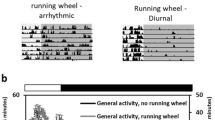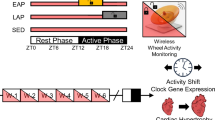Abstract
Objective:
To examine whether scheduled forced wheel activity counteracts the increased body weight gain in rats undergoing chronic circadian desynchronization induced by repeated 12-h shifts in the light–dark cycle.
Design:
Four age- and body weight-matched groups of adult male F344 rats were subjected to 12-h intermittent forced wheel activity daily (2.2 km/day). Each group had the following schedule for 13 weeks: a fixed schedule of a daily 12:12-h light–dark cycle and activity training (WF); a fixed light–dark cycle and 12-h shifts twice a week in activity training (WS); 12-h shifts twice a week in the light–dark cycle and a fixed schedule of activity training (LSWF); and 12-h shifts twice a week in both the light–dark cycle and activity training (LSWS). Two additional age- and body weight-matched sedentary rat groups were selected from our database: one was maintained on a fixed light–dark cycle (LC) and the other was subjected to 12-h shifts twice a week in the light–dark cycle (LS).
Results:
The four rat groups that were exercised showed different response patterns of the daily body temperature rhythm to different combinations of forced activity and lighting schedules. Their food intake was more than that of the two sedentary rat groups, but their body weight was comparable with that of the LC rats and less than that of the LS rats during the forced activity period. The LSWS rats were heavier than the WF and WS rats in the first and second months of the experimental treatment, but their body weight was comparable with that of the WS and WF rats in the third month.
Conclusion:
Forced activity was effective in reducing the body weight gain in chronic circadian desynchronization that was induced by repeated shifts in the light–dark cycle, although such an effect might become significant only after some time.
This is a preview of subscription content, access via your institution
Access options
Subscribe to this journal
Receive 12 print issues and online access
$259.00 per year
only $21.58 per issue
Buy this article
- Purchase on Springer Link
- Instant access to full article PDF
Prices may be subject to local taxes which are calculated during checkout







Similar content being viewed by others
References
Geliebter A, Gluck ME, Tanowitz M, Aronoff NJ, Zammit GK . Work-shift period and weight change. Nutrition 2000; 16: 27–29.
Di Lorenzo L, De Pergola G, Zocchetti C, L'Abbate N, Basso A, Pannacciulli N et al. Effect of shift work on body mass index: results of a study performed in 319 glucose-tolerant men working in a Southern Italian industry. Int J Obes Relat Metab Disord 2003; 27: 1353–1358.
Ishizaki M, Morikawa Y, Nakagawa H, Honda R, Kawakami N, Haratani T et al. The influence of work characteristics on body mass index and waist to hip ratio in Japanese employees. Ind Health 2004; 42: 41–49.
Kawachi I, Colditz GA, Stampfer MJ, Willett WC, Manson JE, Speizer FE et al. Prospective study of shift work and risk of coronary heart disease in women. Circulation 1995; 92: 3178–3182.
Parkes KR . Shift work and age as interactive predictors of body mass index among offshore workers. Scand J Work Environ Health 2002; 28: 64–71.
Rosmond R, Lapidus L, Bjorntorp P . The influence of occupational and social factors on obesity and body fat distribution in middle-aged men. Int J Obes Relat Metab Disord 1996; 20: 599–607.
Van Amelsvoort LG, Schouten EG, Kok FJ . Duration of shiftwork related to body mass index and waist to hip ratio. Int J Obes Relat Metab Disord 1999; 23: 973–978.
Ha M, Park J . Shiftwork and metabolic risk factors of cardiovascular disease. J Occup Health 2005; 47: 89–95.
Niedhammer I, Lert F, Marne MJ . Prevalence of overweight and weight gain in relation to night work in a nurses, cohort. Int J Obes Relat Metab Disord 1996; 20: 625–633.
Karlsson B, Knutsson A, Lindahl B . Is there an association between shift work and having a metabolic syndrome? Results from a population based study of 27 485 people. Occup Environ Med 2001; 58: 747–752.
Boggild H, Knutsson A . Shift work, risk factors and cardiovascular disease. Scand J Work Environ Health 1999; 25: 85–99.
Nakamura K, Shimai S, Kikuchi S, Tominaga K, Takahashi H, Tanaka M et al. Shift work and risk factors for coronary heart disease in Japanese blue-collar workers: serum lipids and anthropometric characteristics. Occup Med 1997; 47: 142–146.
Tsai LL, Tsai YC, Hwang K, Huang YW, Tzeng JE . Repeated light–dark shifts speed up body weight gain in male F344 rats. Am J Physiol Endocrinol Metab 2005; 289: E212–E217.
Harma M . Ageing, physical fitness and shiftwork tolerance. Appl Ergon 1996; 27: 25–29.
Harma MI, Ilmarinen J, Knauth P, Rutenfranz J, Hanninen O . Physical training intervention in female shift workers. I. The effects of intervention on fitness, fatigue, sleep, and psychosomatic symptoms. Ergonomics 1988; 31: 39–50.
Harma MI, Ilmarinen J, Knauth P, Rutenfranz J, Hanninen O . Physical training intervention in female shift workers. II. The effects of intervention on the circadian rhythms on alertness, short-term memory, and body temperature. Ergonomics 1988; 31: 51–63.
Bensimhon DR, Kraus WE, Donahue MP . Obesity and physical activity: a review. Am Heart J 2006; 151: 598–603.
Curioni CC, Lourenco PM . Long-term weight loss after diet and exercise: a systematic review. Int J Obes 2005; 29: 1168–1174.
Hebert JA, Lopez A . Metabolic effects of exercise. II. Residual metabolic effects of exercise in rats. Proc Soc Exp Biol Med 1975; 148: 646–649.
Levin BE, Dunn-Meynell AA . Chronic exercise lowers the defended body weight gain and adiposity in diet-induced obese rats. Am J Physiol Regul Integr Comp Physiol 2004; 286: R771–R778.
Lopez A, Rene A, Bell L, Hebert JA . Metabolic effects of exercise. I. Effect of exercise on serum lipids and lipogenesis in rats. Proc Soc Exp Biol Med 1975; 148: 640–645.
Barger LK, Wright Jr KP, Hughes RJ, Czeisler CA . Daily exercise facilitates phase delays of circadian melatonin rhythm in very dim light. Am J Physiol Regul Integr Comp Physiol 2004; 286: R1077–R1084.
Van Reeth O, Sturis J, Byrne MM, Blackman JD, L'Hermite-Baleriaux M, Leproult R et al. Nocturnal exercise phase delays circadian rhythms of melatonin and thyrotropin secretion in normal men. Am J Physiol 1994; 266: E964–E974.
Edgar DM, Dement WC . Regularly scheduled voluntary exercise synchronizes the mouse circadian clock. Am J Physiol 1991; 261: R928–R933.
Marchant EG, Mistlberger RE . Entrainment and phase shifting of circadian rhythms in mice by forced treadmill running. Physiol Behav 1996; 60: 657–663.
Mistlberger RE . Effects of daily schedules of forced activity on free-running rhythms in the rat. J Biol Rhythms 1991; 6: 71–80.
Reebs SG, Mrosovsky N . Effects of induced wheel running on the circadian activity rhythms of Syrian hamsters: entrainment and phase response curve. J Biol Rhythms 1989; 4: 39–48.
Mistlberger RE, Holmes MM . Behavioral feedback regulation of circadian rhythm phase angle in light-dark entrained mice. Am J Physiol Regul Integr Comp Physiol 2000; 279: R813–R821.
Agren H, Koulu M, Saavedra JM, Potter WZ, Linnoila M . Circadian covariation of norepinephrine and serotonin in the locus coeruleus and dorsal raphe nucleus in the rat. Brain Res 1986; 397: 353–358.
Suzuki K, Machida K . Effectiveness of lower-level voluntary exercise in disease prevention of mature rats. I. Cardiovascular risk factor modification. Eur J Appl Physiol 1995; 71: 240–244.
Mazzeo RS, Horvath SM . Effects of training on weight, food intake, and body composition in aging rats. Am J Clin Nutr 1986; 44: 732–738.
Spier SA, Delp MD, Meininger CJ, Donato AJ, Ramsey MW, Muller-Delp JM . Effects of ageing and exercise training on endothelium-dependent vasodilatation and structure of rat skeletal muscle arterioles. J Physiol 2004; 556: 947–958.
Yokoyama E, Ichikawa I, Uchiyama I . Pulmonary functions of rats trained with mild exercise. Comp Biochem Physiol A 1984; 79: 483–486.
Applegate EA, Upton DE, Stern JS . Food intake, body composition and blood lipids following treadmill exercise in male and female rats. Physiol Behav 1982; 28: 917–920.
Hill JO, Davis JR, Tagliaferro AR . Effects of diet and exercise training on thermogenesis in adult female rats. Physiol Behav 1983; 31: 133–135.
Levin BE, Dunn-Meynell AA . Differential effects of exercise on body weight gain and adiposity in obesity-prone and -resistant rats. Int J Obes 2006; 30: 722–727.
Acknowledgements
We thank Hui-Chuang Chang, Wen-Ju Cheng, Kai Hwang, Wen-Yin Huang, Bessy Hung, Li-Chun Lin, Hau-Min Liu, Pei-Hsiu Tan, Pei-Yu Ting, Chien-Hui Tu and Hsin-Fen Yang for assistance in laboratory animal care and blood and tissue sampling. Histological examinations in this study were performed by Jeh-En Tszeng and Su-Fen Lai at the Department of Pathology, and biochemical examinations for the serum samples were performed by Yu-Wen Huang and Hui-Chun Wu at the Department of Laboratory Medicine, Buddhist Dalin Tzu Chi General Hospital, Chia-Yi, Taiwan, ROC. This study was supported by the National Science Council, ROC. Grants NSC90-2413-H-194-019, NSC91-2413-H-194-014 and NSC93-2413-H-194-021.
Author information
Authors and Affiliations
Corresponding author
Rights and permissions
About this article
Cite this article
Tsai, LL., Tsai, YC. The effect of scheduled forced wheel activity on body weight in male F344 rats undergoing chronic circadian desynchronization. Int J Obes 31, 1368–1377 (2007). https://doi.org/10.1038/sj.ijo.0803607
Received:
Revised:
Accepted:
Published:
Issue Date:
DOI: https://doi.org/10.1038/sj.ijo.0803607



